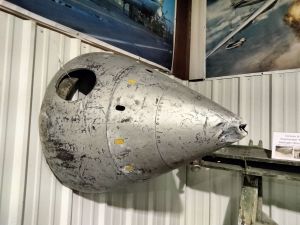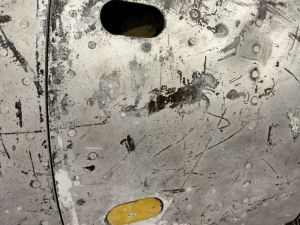
Pic 1: B-36 spinner assembly showing yellow air doors near spinner center. (Fey)

Pic 2: Close up of the air doors. The upper door is missing. (Fey)
Mysteries of the Convair B-36 Propeller: Part 1
by Tom Fey
Published 8 Sep 2023; Revised 13 Sep 2023
Graham White’s R-4360: Pratt & Whitney’s Major Miracle has a page from AN 01-5EUE-2 Handbook of Erection and Maintenance Instructions USAF Series B-36F Aircraft that shows the heated air flow though into the spinner to the prop hub, through the hollow steel blades, and exiting a vent on the fore (camber) propeller blade face trailing edge (Pic 3, Pic 4). This clever design provides anti-icing and deicing functionality to the propeller blades. A ram-air-fed muff surrounding the R-4360 exhaust pipes provides heated air to a pipe that leads to a fixed manifold surrounding the prop shaft. A rigid, rotating inboard spinner shell mates closely with the fixed manifold, sealed by rubber seals, to a rotating manifold with tubes running through the gaps between the three blade hubs into a plenum formed by the conical outboard spinner shell. The heated air then enters the propeller hollow-bore hub, flows into the hollow steel propeller blades, and out the vent near the blade tip (Pic 5, Pic 6, Pic 7).
I obtained B-36 propeller manuals from the National Air and Space Museum (NASM) and tried to figure out the purpose of those little spring-loaded air doors on the outboard spinner. It is clear from the spinner I saw in person and the one drawn in manuals, with doors that open inward (Pic 8). The prop manuals contained no specific information on the spinner air doors. There may be more complete information in the B-36 Erection Manual, but I don’t have economical access to those documents. However, I think I have figured out the purpose of those doors.
When the deice function is activated, heated air generated by a heating muff surrounding the engine exhaust pipes feeds, via manifolds and transfer joints, the prop hub center, to be exhausted through the blade vents. When the deice function is not enabled, a butterfly valve closes the hot air pipe feeding the prop hub and shunts the heated air overboard.
White's book says takeoff power for the R-4360-53 in the B-36, with a 2.6667:1 propeller reduction ratio, is 3,800 hp at 2,800 rpm (prop speed 1,050 rpm) while cruise power is 2,800 hp at 2,600 rpm (prop speed 975 rpm). What I can say is that with a 19 foot 1 inch diameter propeller spinning at 975 rpm in cruise, the relative centrifugal force (RCF) at the blade tip is 3,090 times the force of gravity. The RCF mid-span on a blade is 1,545 x g. That means an additional one ounce of mass placed at the tip of the spinning blade would "weigh" 193 pounds, or 96 pounds if positioned half-way down the blade. A standard cubic foot of air weighs 0.0807 lb, and if that cubic foot of air was contained in, say, the last four feet of the propeller blade, it would have an average RCF of 1618 x g acting upon it, equivalent to a centrifugally-induced force of 131 pounds.
My belief is that it is the RCF that propels the heated air through the 114” blade length, not the pressure from the heated feed air. If that is the case, when you close the feed air butterfly valve there could be significant vacuum generated in the spinner, hub, rotating joint, manifold, and butterfly valve feed pipe by the spinning blades. This could require heavier components to deal with the stresses of negative pressure and/or magnify the friction and wear on the rotating seal on the inboard spinner shell.
The answer to the vacuum dilemma is to vent the spinner air system when pressure goes negative! I believe that is exactly the purpose of those little suck-in doors on the spinner. When the heated air feed butterfly valve is closed, the spinner air doors open automatically.
I’ll keep digging around trying to find official confirmation of the air door purpose, but until I find otherwise, that is my story and I’m sticking to it.